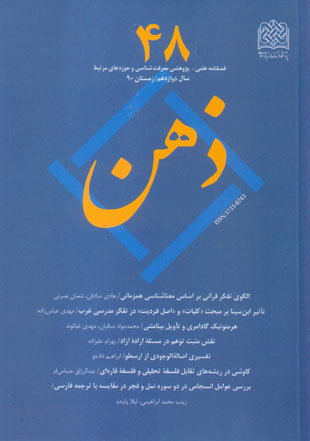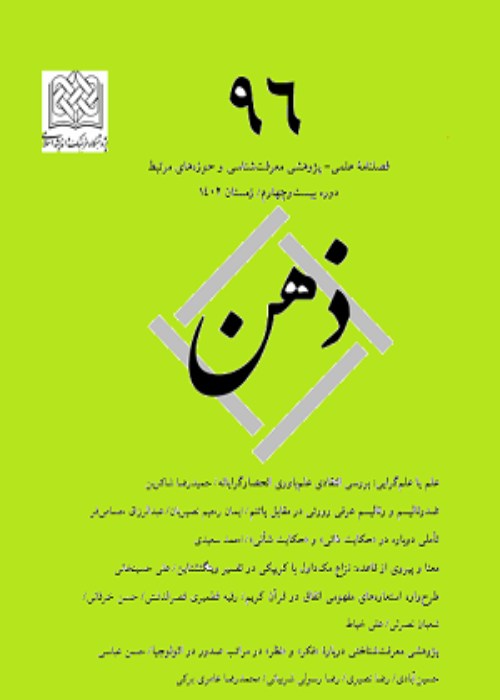فهرست مطالب

فصلنامه ذهن
سال دوازدهم شماره 4 (پیاپی 48، زمستان 1390)
- 188 صفحه، بهای روی جلد: 40,000ريال
- تاریخ انتشار: 1390/11/25
- تعداد عناوین: 7
-
-
تاثیر ابن سینا بر مبحث «کلیات» و «اصل فردیت» در تفکر مدرسی غرب / بررسی موردی: دنس اسکوتوسصفحه 29
-
صفحه 103
-
Page 5Through a model of synchronic semantics, the present writing will discuss semantically the term "thinking" (fikr) and goes into three fields of "syntactic, paradigmatic, and syntagmatic" and comes to the conclusion that the Holy Quran notes that there are two kinds of thought system. Characteristics of one of them are dynamism, collectivism, convergence, and faith-centeredness; and this is the one which is confirmed by the Holy Quran. This system of thinking falls in the scope of the Quranic knowledge. The other system has been founded on individualism, sluggishness, and faith-phobia; this system is sometimes publicly welcomed. The Holy Quran uses two terms "thinking" (fikr) and ignorance (jahl) to mention this kind and puts it out of the scope of knowledge. To invite people to think, the Holy Quran employs two methodologies of analogy and report. To note the object of thinking, the Holy Quran makes uses of diversity of objects and insists mostly upon ordinary and natural things. According to the Quranic view, thinking is not mainly expected to produce new knowledge; but rather the aim of thinking is that man takes the previous knowledge as a context in which he may think so that a window to faith may be opened to him.Keywords: semantics, semantics of thinking, syntagmatics of thinking, paradigmatic of thinking
-
Ibn Sina's Impact on "Universals" and "Principle of Individuation" in the Western Scholastic Thought / Case Study: Duns ScotusPage 29This writing is to explain the scope of the Impact of Ibn Sina's ideas on one of the most controversial philosophical issues in the Christian Middle Age and in particular scholastic thought, i.e. "universals" and consequently the "principle of individuation" with an eye to the ideas of the Scottish philosopher and theologian, Johannes Duns Scotus (1266- 1308) and the way that such impact appears. Discussion about universals and its threefold divisions, in particular "natural universal" and its existence or nonexistence in the external world and consequently the principle of individuation, i.e. the origin of the particular external objects, is among very important and decisive issues which begins in the western scholastic thought entirely under Ibn Sina's impact and leads to long debates between Christian philosophers and theologians. From among Ibn Sina's works, Scotus had studied his al-Shifa which was translated into Latin in 12th Century. Like other scholastic thinkers before him, he has discussed universals in details. His view is, however, entirely influenced by Ibn Sina and adopted from the latter's ideas. In the way he has introduced universals, three kinds of universals, and in particular in the way he discusses "natural universal", its external existence and the mode of this existence, he refers directly to Ibn Sina's ideas; though about the way of unity of natural universal in the external world, his ideas differ slightly from those of Ibn Sina. Also, in negating Platonic Ideals, he is completely influenced by Ibn Sina. Though in discussing principle of individuation he is like other scholastic thinkers influenced by Ibn Sina, his explanation is completely innovative and entirely independent from Ibn Sina's view. Introducing thisness (haecceitas) as the principle of individuation, he goes far from Ibn Sina who considers "personal properties and accident" as the agent of individuation.Keywords: universals, universal, natural universal, common nature, principle of individuation, particular
-
Page 51After giving a brief overview of the Gadamer’s philosophical hermeneutics and term "Itertextuality" used by Kristeva, and showing consequences of these concepts on reading, understanding and interpreting of texts, the aim of this article is to offer an comparative account of the two approaches. For drawing the picture of hermeneutics in the mirror of intertextuality, we should first of all, discuss the concept of text. For Kristeva, any text is the absorption and transformation of other texts and so she calls it a production. In this way, the act of reading, plunges us into a network of textual relations and to interpret a text, to discover its meaning, or meanings, is to trace those relations. So in Kristeva's hermeneutics assertions of objectivity, scientific rigors, methodological stability and other highly rationalistic-sounding terms are replaced by an emphasis on uncertainty, indeterminacy and some other ideas like the "death of author".Keywords: Hermeneutics, Intertextuality, subject, Language, temporality, objectivit
-
Page 79Illusionism is the view that illusion often have a large and positive role to play in the free will issue. According to this position; (1) There is no libertarian free will because libertarian free will is incoherent and thus impossible. (2) Compatibilism is generally insufficient as a basis for moral responsibility and related matters. (3) Hard determinism is also generally unconvincing, because there are basic morally beliefs that ought not to be abandoned, although they might based on incoherent conceptions. Now, we can see how illusion is important. This importance indirectly flows from the Fundamental Dualism of the partial validity of compatibilism and hard determinism, and directly from the absence of libertarian free will. In this paper, I will describe this view and give some argument against it.Keywords: Free will, Fundamental dualism, Illusionism, Moral responsibility, Saul Smilansky
-
Page 103The doctrine of asalat al-wujud (Principiality of Existence) is perhaps the most important basis of Mulla Sadra's philosophy. Mulla Sadra is mostly considered as the first founder of this doctrine. The doctrine of "principiality of existence and mentally-positedness of quiddity" has been interpreted in three ways" 1- quiddity is "existential limit" of existence; 2- quiddity is "mental limit" of existence"; and 3- quiddity is "the same as existence". The two first interpretations are caused by confusion between subject and object and confusion between epistemology and ontology. The best interpretation of the doctrine of "principiality of existence and mentally-positedness of quiddity" is the third interpretation according to which quiddity is "the same as existence". The author of the present article seeks to show that concerning "existence" and "quiddity" Aristotle is of an opinion which is the same as the third interpretation- "principiality of existence and mentallypositedness of quiddity". Having distinguished "existence" from "quiddity" in the mind, Aristotle claims for "sameness of existence and quiddity" in the external; world; and this is the same as Mulla Sadra's idea of "principiality of existence and mentally-positedness of quiddity".Keywords: existence, quiddity, principiality, mentally, positedness, principiality of existence, principiality of quiddity, existent, substance, form, cause, Aristotle, Mulla Sadra
-
Page 131The Confrontation of Analytic Philosophy and Continental Philosophy in the 20th century and continuity of the divergence between two sides have provoked some scholars to do research about the roots of this split and sometimes to ask for a way to approximate these two traditions. Among these studies Bernstein and Freidman’s opinions has had more reflection. Bernstein introduces praxis and action as the common elements of the important contemporary philosophical schools while Freidman take the encounter of three sages of contemporary philosophy, Cassirer, Heidegger and Carnap at Davos in 1929 as the root of the split. The cause of split according to him, from philosophical point of view is the approach to the logic and from political point of view is the position on or upon Nazism. But in opposition to him Tam Rackmore reduces the disagreement to the theory of knowledge and denies reducing it to the political issues. In this article Bernstein and Freidman’s ideas on the subject and their critics have been investigated.Keywords: Praxis, Davos encounter, Cassirer, Heidegger, Carnap, logic, knowledge, Nazism
-
An analysis of cohesive ties in AL- Naml and AL- Fajr surahs comparing to their Persian translationsPage 155This article studies the cohesive ties in AL– Naml and AL– Fajr surahs, based on discourse analysis rules and Halliday and Hassan’ ideas and since in translation of this holy book, Quran, the texture and text system are of special importance, it compares these ties to their Persian translation. The following results were obtained after studying and comparing the cohesive ties: 1) There is no complete correspondence between these surah's cohesive ties. And those of translated ones. ties. The application of cohesive ties in AL-Naml is 45/09% but in its Persian translation is 34/49% and the usage of cohesive ties in AL-Fajr is 40/19% but in its Persian translation is 36/01% 2) The cohesive ties referent has been used mostly in these 2 surahs and their translation.Keywords: discourse analysis, cohesion, cohesive ties, text linguistics, The Holy Quran


